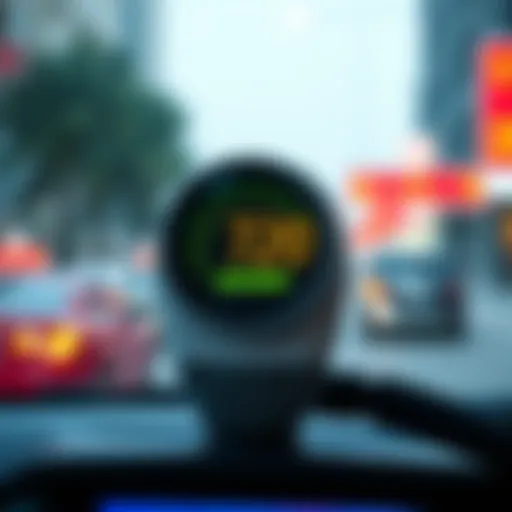Taxi Application Insights: The Dubai Landscape


Intro
In the bustling city of Dubai, where skyscrapers touch the clouds and the streets hum with activity, the taxi application landscape has evolved significantly, mirroring the rapid technological advancements synonymous with the region. Gone are the days when hailing a taxi involved merely raising your hand. Now, with a simple tap on a smartphone, one can summon a ride in mere minutes. This shift is not just about convenience; it reflects deeper trends in urban transport, consumer behavior, and regulatory frameworks that shape this vibrant environment.
Understanding this landscape requires an exploration of multiple facets, from user experiences and service options to the challenges and regulations that guide taxi services in Dubai. As we dive deeper into the intricacies of ride-hailing applications, it becomes clear that these platforms are not just invaluable tools for millions but also a market ripe with investment opportunities for savvy entrepreneurs and developers. Let's embark on this journey to uncover how technology intertwines with transport, enhancing everyday life in one of the world’s most dynamic cities.
Intro to Taxi Services in Dubai
Taxi services in Dubai have become an integral part of the transportation landscape. They are not just a means to get from point A to point B; they represent a blend of convenience, technology, and cultural adaptation. With the city's rapid development and influx of tourists and residents from various backgrounds, the demand for reliable and efficient taxi services has risen significantly.
The importance of understanding taxi services in Dubai goes beyond mere superficial knowledge. For investors and developers looking to enter the transportation sector, having insights into the operational framework, user preferences, and regulatory aspects is crucial. One of the most significant benefits of taxis in Dubai is their accessibility. Rather than relying solely on public transport or private vehicles, taxis offer a flexible option that meets the diverse needs of residents and visitors alike.
Key Points
- Convenience: Taxis in Dubai are available 24/7, making them a dependable choice for both locals and tourists.
- Technological Advancements: Many taxi services here incorporate advanced technology, such as GPS navigation and mobile applications, enhancing user experience. This not only provides efficient routes but also ensures safety through real-time tracking.
- Rider Safety: Taxis are regulated by governmental bodies, ensuring that drivers meet specific standards that promote safety and reliability. With the introduction of ride-hailing apps, riders can check driver ratings and vehicle details before getting inside.
- Regulatory Framework: The government actively oversees taxi operations, instilling trust in the services provided. Understanding these regulations helps investors navigate the legal landscape effectively.
In summary, taxi services are not merely a facet of transportation in Dubai; they embody a confluence of safety, convenience, and technological progress. For those involved in real estate or development within the region, grasping the dynamics of taxi operations can lead to advantageous business strategies. As the market continues to evolve, aligning with these changes may unlock new opportunities.
"Navigating the taxi landscape in Dubai requires an understanding of both the market's intricacies and the evolving needs of its users."
For a deeper dive into the specifics surrounding taxi operations, governmental insights can be found at Dubai Government.
Further exploring global standards in taxi services can be beneficial, and websites such as Britannica offer relevant information on transportation systems worldwide.
Overview of Taxi Applications
Navigating the taxi application landscape is crucial to understanding how transportation is evolving in Dubai. Taxi applications have transformed the way people commute, turning what was once a manual process into a seamless digital experience. They provide significant advantages to users and operators alike, catering to a bustling metropolis striving for efficiency, safety, and convenience. The exploration of this topic serves as a foundation for understanding the interconnected components that drive the transportation ecosystem in Dubai.
Importance of Taxi Applications
Taxi applications represent a modern approach to transportation, making it essential for various stakeholders, including investors, real estate professionals, and daily commuters. These applications harness technology to enhance user experience and accessibility.
The key benefits include:
- Convenience: Users can order a ride at their fingertips, reducing wait times significantly.
- Transparency: Users can see fare estimates and track their rides in real time, promoting both safety and trust.
- Flexibility: Various options, including ride-sharing, luxury, and budget rides, cater to diverse consumer needs without restriction.
These advantages highlight why taxi applications are a pivoting point in Dubai’s transportation narrative.
"In a city known for its rapid pace and innovation, taxi applications are emblematic of Dubai's commitment to leveraging technology for improved urban mobility."
Definition of Taxi Applications
Taxi applications can be described as mobile platforms designed to connect passengers with drivers through a digital interface. They facilitate the booking, scheduling, and payment processes for rides, enhancing user interaction with taxi services. Unlike traditional taxi services that required legwork or long waits, these apps digitize those functions, thus streamlining the entire experience. Key examples include Careem and Uber, which have established themselves within the Dubai market.
How Taxi Applications Function
Understanding the mechanics behind taxi applications unveils their complexity and efficiency. These applications operate on several core principles:
- User Registration: Customers create an account, inputting their personal details.
- Location Services: By utilizing GPS technology, the app pinpoints the user's location, simplifying the ride-request process.
- Ride Request: Users select their desired ride option and request a trip, which sends a signal to nearby drivers.
- Driver Acceptance: Nearby drivers receive the request and can accept or decline based on their availability.
- Navigation: Once a driver accepts, the app provides optimal routing for both the driver and rider, ensuring efficiency and reduced wait times.
- Payment: Payment is often done digitally, either through an integrated system within the app or various other payment methods offered.
This functionality illustrates the sophisticated integration of technology and user-oriented design in taxi applications, making them indispensable in the modern transport landscape.
Key Players in the Dubai Taxi App Market
The taxi app market in Dubai is crucial, serving as a significant part of the transportation network. Understanding the key players is essential for anyone looking to navigate this landscape, whether it's investors, real estate professionals, or potential users. With various government-operated and private ride-hailing services available, each player brings something unique to the table, leading to an overall enhancement of user experience and efficiency in urban mobility.


Government-operated Taxi Services
In Dubai, government-operated taxi services, primarily represented by the Roads and Transport Authority (RTA), play a vital role. Governed by strict regulations, these services ensure a level of reliability and safety that is hard to match. Established years ago, the RTA oversees a fleet that adheres to high standards, offering clear pricing structures and trained drivers. This makes them a preferred choice for many residents and tourists, as they often guarantee consistent quality and professionalism.
The RTA integrates technology into its services as well. Users can book taxis through an official app, which streamlines the process of getting a ride. The app enables users to locate the nearest taxi and track its arrival time, thus adding an extra layer of convenience. Moreover, the RTA is constantly looking to modernize its fleet, demonstrating a commitment to sustainability with hybrid and electric vehicles.
Private Ride-hailing Services
On the flip side, private ride-hailing services, such as Uber and Careem, have disrupted the traditional taxi market. These platforms offer flexibility and often quicker response times as users can hail rides from their smartphones. The convenience factor becomes apparent, considering the rapid urbanization of Dubai and the demand for swift transport options.
These services typically provide various vehicle types, letting users select based on their need and budget. Whether it's a standard ride, a luxury option, or even an economic carpool, private services enable users to customize their experience. Additionally, one noteworthy aspect is the dynamic pricing used by platforms like Uber, which adjusts fares based on real-time demand and availability, something that contrasts with the fixed pricing of government-operated taxis.
Comparison of Major Apps
To understand which service suits which user best, a comparison of the major apps is necessary:
- RTA Taxi App: Ideal for those who value reliability with fixed pricing. It’s handy for quick ride-hailing in busy areas, especially at peak hours.
- Uber: Offers a broader range of services and real-time tracking, but pricing can fluctuate based on demand. It’s often favored by tourists and those seeking flexibility.
- Careem: A local favorite, Careem not only competes with international players but excels in local knowledge. Its promotions and loyalty programs can make it appealing.
The landscape of taxi applications in Dubai is marked by dynamism and diversity. Government-operated services offer stability, while private players focus on flexibility and customer-centric experiences.
As the competition heats up, each player is compelled to innovate, leading to better services across the board. This is particularly beneficial for the end-users, who find themselves with a suite of options to choose from. With this ecosystem, understanding the key players provides valuable insights, aiding in decision-making whether one is traversing the city's vibrant streets or evaluating investments in the transport sector.
For more detailed insights, you can check additional resources such as Wikipedia, or the RTA official website.
This comprehensive understanding of the key players equips readers with the tools to make informed decisions, whether they’re hailing a cab or considering entering the market.
User Experience and Interface Design
In the realm of taxi applications, user experience and interface design stands as a cornerstone of success. A well-designed interface not only attracts users but also enhances their overall satisfaction, which is paramount in an environment as bustling and variable as Dubai. Users expect smooth interactions. The design should facilitate quick bookings, uncomplicated navigation, and swift access to essential features. This delicate balance is crucial in retaining customers and ensuring repeat usage of an app. An app that frustrates users will ultimately find itself gathering digital dust.
App Usability and Accessibility
The foundation of app usability hinges on creating interfaces that are intuitive. Key elements, such as the layout and ease of navigation, play significant roles. For instance, a user might not have the patience to finesse their way through a labyrinth of menus when they need a ride in a hurry. Accessibility should not be an afterthought. Features such as voice commands and large, easily readable buttons can significantly enhance the experience for users who may not be as tech-savvy or those with disabilities.
- Simple Navigation: Users appreciate when they can quickly find ride options and book them without a hitch.
- Language Options: Providing multiple language settings in an international city like Dubai can greatly enhance user satisfaction.
Moreover, a focus on responsive design ensures applications run seamlessly on various devices. Users are increasingly using smartphones to book rides when they’re out and about. Therefore, having a mobile-first approach will improve user experience tremendously.
Navigation and Route Optimization
The essence of a taxi application's functionality often lies in its ability to optimize routes efficiently. Integrating real-time GPS data not only aids in navigation but also improves the overall reliability of the service. When users are in a rush, optimal routing is not just a luxury; it's a necessity. Such systems leverage algorithms that consider factors like traffic congestion, road closures, and even user preferences regarding routes.
Consider this: A traveler hopping off a flight at Dubai International Airport wouldn't want to find themselves stuck in gridlock due to outdated information.
- Dynamic Route Adjustments: Allowing the application to suggest alternate routes in real time can save users precious minutes.
- User Preferences: Giving users the ability to customize their ride, such as avoiding toll roads or preferring shorter distances, can also enhance satisfaction.
Payment Systems and Options
In the case of taxi applications, flexibility in payment systems can make or break user experience. People favor convenience, and offering diverse payment methods is essential. From traditional credit and debit cards to modern wallets like Apple Pay and Google Pay, the wider the array of options, the better.
- In-App Transactions: An easy in-app payment process is key for smooth experiences. A couple of taps, and users should be good to go.
- Transparency in Pricing: Users should be able to see fare estimates upfront. This builds trust and prevents any surprises at the end of a journey.
- Split Fare Features: Given the social nature of many rides, allowing fare splitting among passengers is an attractive option.
"Providing multiple payment options makes for a hassle-free user experience, paving the way for happier customers and fewer abandoned rides."
Market Trends Affecting Taxi Applications


Understanding the market trends that influence taxi applications in Dubai is crucial for stakeholders looking to grasp the evolving landscape of ride-hailing services. The taxi app ecosystem isn't static; it’s shaped continuously by technological advancements, shifting consumer needs, and regulatory developments. These trends provide insight into what’s working, what isn’t, and where the market is headed.
Integration of Artificial Intelligence
Artificial Intelligence (AI) is more than just a buzzword—it’s enhancing various aspects of taxi applications in Dubai. AI algorithms analyze traffic patterns and user data, enabling apps to suggest optimal routes. This not only cuts down on travel time but also helps in minimizing fuel consumption.
Besides routing, the customer experience improves through AI by offering personalized content tailored to user preferences, whether it’s reminders of past destinations or promotional offers. Such a level of customization increases app engagement, which translates into higher user retention rates.
AI's predictive capabilities are also noteworthy. By leveraging historical data, apps can forecast demand in specific regions, allowing for better resource allocation. This means that during peak hours or special events, more drivers can be made available, thus enhancing reliability. In short, the integration of AI into taxi applications signals an era of efficiency and customer-centric offerings in Dubai.
Sustainability and Eco-friendly Initiatives
As the world tilts towards sustainability, the taxi service industry in Dubai is not lagging behind. Eco-friendly initiatives are becoming a significant trend among taxi applications. Companies are now prioritizing electric vehicles (EVs) within their fleets, responding to both regulatory pressures and consumer demand for greener options.
The government has set ambitious goals to promote sustainability. The Dubai Clean Energy Strategy aims to ensure that 25% of all trips are made using electric vehicles by 2030. Many taxi apps are embracing this with clear strategies to incorporate EVs into their fleets, thus contributing to lower emissions and making a mark in the race towards carbon neutrality.
Additionally, app interfaces are now including features that encourage users to choose greener transports. For instance, users can see the environmental impact of their ride choices, which helps foster an eco-conscious mindset among consumers. Simply put, sustainability isn’t merely a trend—it’s quickly becoming an expectation in the taxi application world.
Shifts in Consumer Behavior
Consumer behavior is a reflection of societal changes and technological advancements, and in Dubai, it’s shifting rapidly. Users are increasingly leaning towards convenience, flexibility, and personalized ride experiences. As a result, taxi applications are adapting to meet these ever-evolving demands.
For one, there’s a significant trend towards on-demand ride services, where convenience reigns supreme. Users prefer the ease of booking a ride at their fingertips rather than calling a taxi. Moreover, many consumers now seek options beyond just point A to point B—services that offer hybrid transport solutions, like ride-sharing and shuttle services, are gaining traction.
The demographic shift also influences these changes. Younger generations, who are more tech-savvy, are increasingly important to the market. Their preferences for various payment options—like digital wallets—are forcing a rethink of traditional payment methods in taxi applications.
As the taxi applications in Dubai continue to evolve, adapting to these trends is not optional but essential for success.
By grasping these market trends, all participants, from app developers to investors, gain invaluable insights into what the future holds for taxi services in Dubai.
Regulatory Landscape
In any city, the regulatory landscape plays a pivotal role in shaping how services operate, especially in complex markets like ride-hailing in Dubai. This section delves into the significance of governmental oversight, compliance requirements, and how these elements influence competition within the taxi application ecosystem. Regulatory frameworks are designed not only to ensure safety and quality but also to foster innovation and maintain a level playing field for all participants. Thus, an understanding of regulations is crucial for anyone involved in, or researching, the taxi application sector in this emirate.
Government Regulations and Compliance
In the realm of taxi services, government regulations serve as the backbone for operational integrity and consumer protection. The Roads and Transport Authority (RTA) in Dubai sets stringent guidelines that all taxi applications must adhere to. These regulations encompass various aspects such as:
- Driver Licensing: All drivers are required to undergo thorough background checks and acquire necessary permits, which assures passengers of their credibility.
- Vehicle Standards: Taxi vehicles must meet specific safety and cleanliness criteria, ensuringthat passengrs have a safe and pleasant journey.
- Fare Structures: Regulations dictate fare models, protecting consumers from exorbitant pricing and ensuring fairness in charges across different service providers.
Compliance to these regulations is paramount. Non-compliance could lead to hefty fines or the suspension of services, which serves as a significant motivator for apps to operate within the guidelines set forth by the RTA. This framework not only benefits the end-users but also promotes a sense of accountability among service providers.
Impact of Regulations on Competition
The impact of regulations on competition in the Dubai taxi app landscape is profound, influencing how services engage with each other and with customers. Here are several outcomes stemming from the existing regulatory framework:
- Market Entry Barriers: Stringent compliance measures can create hurdles for new entrants. While this protects the consumer, it can stifle diversity in services offered, potentially leading to a handful of dominant players.
- Service Quality Improvements: With regulations in place, established companies often strive to enhance their service offerings. They might invest in technology or customer service training to differentiate themselves from competitors, leading to overall improved user experiences.
- Price Stabilization: By controlling fare structures, regulations can help stabilize taxi pricing, thereby preventing price wars that could harm both consumers and service providers in the long run.
In summary, while regulations may appear as barriers, they can also incentivize improvement and lead to a healthier competitive environment in the taxi app market. Understanding these dynamics is essential for any stakeholder looking to navigate Dubai’s intricately woven transportation tapestry.
"Regulatory frameworks are the unsung heroes of the transportation sector—ensuring safety while fostering innovation."
For those looking to dive deeper into the regulatory aspects, you may refer to the RTA's official website for comprehensive guidelines and updates.


Challenges Faced by Users
The taxi application market in Dubai has seen a meteoric rise, but like any bustling metropolis, it’s not without its bumps on the road. Users, while generally benefiting from the convenience these apps offer, face several challenges that can dampen their overall experience. Understanding these concerns is crucial, not just for the users themselves, but also for companies looking to refine their services and better cater to their clientele. This section lays out the major hurdles users encounter, ensuring a comprehensive dialogue around the merits and downfalls of taxi applications in Dubai.
Safety and Security Concerns
Safety is paramount in the transportation industry. As ride-hailing services proliferate, users often worry about their safety during rides. Various factors contribute to these concerns, such as the necessity for driver verification and the protection of passengers' personal information. Users have voiced apprehensions over verification processes—how stringent are they? Are background checks robust enough to assure passengers of their safety?
Many users have had instances where they felt uneasy about getting into a vehicle with a stranger, even if the app facilitates a seemingly secure arrangement. Moreover, there have been reports of incidents that sparked larger public outcries, reminding us that vigilance is always necessary.
Most taxi applications have responded by incorporating safety features such as ride-tracking options, SOS calls, and even revenue-sharing systems to incentivize safer driving. However, these measures do not entirely allay fears. It’s imperative for companies to continually fine-tune their safety protocols, educating drivers and users alike on best practices while using the service. As one rider shared:
"I love the convenience, but I can't help but feel a bit nervous every time I step into a car."
Reliability and Availability of Services
Another major pitfall for users relates to service availability and reliability. While taxi apps often advertise their ability to summon rides on-demand, in reality, this isn’t always the case. Users may find themselves stuck waiting longer than anticipated, especially during peak hours or adverse weather conditions. This waiting game can lead to missed appointments or tardiness, ultimately erasing the promise of convenience.
In addition, the supply of drivers can fluctuate dramatically, particularly in a city like Dubai, which attracts a diverse array of visitors and locals alike. Many have experienced scenarios where the app shows available cars nearby only for them to vanish moments later. This inconsistency frustrates users, leading them to second-guess their choice of transportation. Some have even resorted to traditional taxi services, viewing them as a more reliable means of travel when all else fails. To combat this, taxi applications need to improve their driver recruitment and retention strategies, making sure that the supply matches the demand.
Cost and Pricing Issues
When it comes to finances, clarity is king. Users have often encountered pricing models that can feel puzzling—a situation that’s been described as feeling like being "nickeled and dimed." Surge pricing during high demand can inflate costs significantly, catching passengers off guard. It’s not unusual for users to abandon rides at the last second because the fare suddenly skyrocketed, leading to an unplanned scramble for other options.
Additionally, some applications have short-lived promotional offers that lure in users, but once these incentives fade, the prices can be less competitive than traditional taxi services. The frequent changes in pricing add another layer of complexity that leaves users skeptical about whether they'll get their money’s worth.
To enhance user trust and satisfaction, transparency in pricing should be prioritized. Companies might consider providing clear fare breakdowns before rides commence and reinforcing value, particularly during surcharge periods. Emphasizing straightforward pricing practices could do wonders for user retention.
The Future of Taxi Applications in Dubai
The taxi landscape in Dubai is evolving at a rapid pace, and understanding the future of taxi applications is crucial for various stakeholders including investors, city planners, and commuters. As advancements in technology reshape urban mobility, it becomes increasingly important to analyze potential shifts in taxi services. The integration of innovative features not only enhances user experience but also addresses pressing concerns in urban transportation.
Potential Innovations and Developments
Looking ahead, a number of potential innovations are on the horizon for taxi applications in Dubai. Here are a few that stand out:
- Autonomous Vehicles: With significant investments in autonomous vehicle technology, ride-hailing services in Dubai may soon feature self-driving cars. Companies like Waymo are paving the way, and local initiatives could follow.
- Enhanced User Interface (UI): The future apps are likely to boast even more intuitive designs. Employing user research, apps can create dashboards that allow passengers to seamlessly navigate options, with personalized features catering to individual preferences.
- AI-driven Analytics: Using artificial intelligence to analyze patterns in user behavior can lead to smarter route planning and better demand predictions. This results in more efficient rides and reduced wait times.
- Geolocation Services: Enhanced GPS capabilities can facilitate more precise pick-up and drop-off locations, minimizing user confusion and improving the overall experience.
- Sustainability Features: An increase in greener options like electric vehicles can cater to environmentally-conscious customers. A recent survey suggested 70% of users are willing to switch to greener alternatives if available.
- Integrated Transportation Solutions: Enabling seamless connectivity with public transport networks can prove beneficial. Users might switch from a taxi app to a Metro-bus connection without hassle, allowing for smoother commutes throughout the city.
"The evolution of technology is not just a trend; it's a necessity to keep up with growing urban populations and their demands for efficient transport solutions."
Forecasting User Adoption Trends
Predicting user adoption trends in taxi applications involves analyzing various factors. Here are some key considerations:
- Convenience and Flexibility: Modern consumers expect convenience. Features such as scheduling rides in advance and receiving notifications about ride status can dramatically enhance user experiences. Therefore, apps that evolve to meet these expectations will likely see higher adoption rates.
- Affordability: As more options emerge, price sensitivity will play a role in user choices. Comparative pricing models based on service features can offer users the best bang for their buck.
- Trust and Safety: Users will gravitate toward applications that prioritize their safety. Implementing robust safety features, such as driver verification and real-time ride tracking, will become a staple for building trust within the user community.
- Public Awareness Campaigns: Marketing plays a crucial role in adoption. Successful taxi apps in Dubai may invest in educating users about the benefits of their services, particularly features relating to payment options and safety measures.
- Social Trends: Dubai's diverse population means cultural trends will also influence user adoption. Apps that support multiple languages and offer culturally relevant service options will likely have better uptake.
End
As we draw the curtains on our thorough examination of taxi applications in Dubai, it’s essential to underscore the significance of the insights we've gathered. This article not only shines a light on the current state of the landscape but also peels back the layers on the challenges and emerging trends influencing the future.
Taxi services are not merely a convenience; they serve as a lifeblood for residents and visitors alike. With the rapid influence of technology, understanding how these applications operate can be a game-changer for investors, developers, and users alike. Users must grasp how various apps, from government-operated services like Dubai Taxi to private contenders such as Uber and Careem, shape their travel experiences and choices.
For investors, recognizing the trends can provide strategic advantages. The emphasis on user experience, from ease of use to payment options, can dictate which services thrive. Similarly, new technologies like AI and machine learning promise efficiencies that could redefine user expectations and service reliability. As competition heightens, discerning the quieter shifts—like shifts in consumer behavior toward greener transport options—will be crucial.
Moreover, the regulatory framework is not just a background player but a vital aspect of this landscape. Effective regulations can stimulate healthy competition, ensuring that taxi services are safe and reliable, encouraging growth in this sector. However, stakeholders must stay vigilant and adaptive to avoid pitfalls that could stymie innovation.
"Understanding the landscape means not only seeing what is in front of you but also anticipating shifts in the horizon."
In weighing these elements, one can appreciate the delicate balance this market maintains between user satisfaction, profitability, and regulatory compliance. This article hopes to provide readers with a comprehensive grip on how the taxi application ecosystem in Dubai intertwines with broader economic and societal trends.
In closing, the future of taxi apps in Dubai is not only about technological advancement but also about addressing user concerns and embracing sustainability. It’s a dynamic scene where each stakeholder plays a pivotal role in shaping transport services that meet modern demands. Staying informed and engaged with these developments can ultimately lead to smarter choices for everyone involved.















